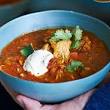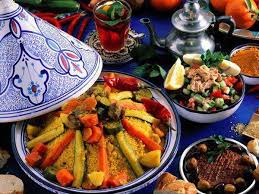The Delightful Flavours of Moroccan Cuisine: Exploring the Tagine
When it comes to Moroccan cuisine, one dish stands out as a symbol of the country’s rich culinary tradition—the tagine. This iconic North African dish is not just a meal; it’s a cultural experience that brings together a harmonious blend of flavours and textures.
What is a Tagine?
A tagine refers to both the earthenware pot in which the dish is cooked and the stew-like meal itself. The conical shape of the tagine pot allows for steam to circulate during cooking, resulting in tender and flavourful dishes.
The Ingredients
One of the key elements that make a tagine so special is its ingredients. Typically, a tagine consists of slow-cooked meat—such as lamb, chicken, or beef—combined with an array of spices like cumin, turmeric, cinnamon, and saffron. Vegetables like tomatoes, onions, and olives are also commonly used to add depth to the dish.
The Cooking Process
Preparing a tagine is more than just cooking; it’s an art form. The slow cooking process allows the ingredients to meld together, creating complex layers of flavour. Traditionally, tagines are cooked over charcoal or on a low flame for hours until the meat is tender and infused with all the spices.
Serving and Enjoying
Tagines are often served with fluffy couscous or crusty bread to soak up the delicious sauce. The communal aspect of sharing a tagine adds to its appeal—it’s a dish meant to be enjoyed with family and friends around a table laden with other Moroccan delights.
Variations and Regional Specialties
While there are traditional recipes for tagines, each region in Morocco puts its own spin on this classic dish. From seafood tagines along the coast to vegetable-based versions in the Atlas Mountains, there’s no shortage of variations to explore.
Experience Morocco Through Its Cuisine
The tagine encapsulates the essence of Moroccan hospitality and culinary prowess. With its aromatic spices, succulent meats, and vibrant vegetables, this iconic dish invites you on a sensory journey through the bustling souks and sun-drenched landscapes of Morocco.
Next time you crave an exotic culinary adventure, consider preparing or sampling a tagine—it’s not just food; it’s an invitation to immerse yourself in the flavours of Morocco.
Exploring the Essentials of Moroccan Tagine: Frequently Asked Questions
- What is a tagine?
- What are the traditional ingredients used in a Moroccan tagine?
- How is a tagine cooked?
- What makes a tagine different from other stews?
- Are there vegetarian or vegan versions of the tagine available?
- Can I make a tagine at home without a traditional clay pot?
- What are some popular variations of the traditional Moroccan tagine?
- Is couscous always served with a tagine?
- Are there any specific etiquettes or customs associated with eating a Moroccan tagine?
What is a tagine?
A tagine is a quintessential Moroccan dish that encompasses both the earthenware pot in which it is cooked and the aromatic stew-like meal itself. The distinctive conical shape of the tagine pot allows for gentle steam circulation during cooking, resulting in tender and flavourful dishes. Typically made with slow-cooked meat, an array of spices, and vegetables, the tagine is a culinary masterpiece that captures the essence of Moroccan cuisine. This traditional North African dish not only delights the taste buds but also offers a cultural experience that showcases the rich heritage and flavours of Morocco.
What are the traditional ingredients used in a Moroccan tagine?
In a traditional Moroccan tagine, a harmonious blend of aromatic spices and fresh ingredients come together to create a symphony of flavours. Commonly used spices include cumin, turmeric, cinnamon, and saffron, each adding its own unique touch to the dish. The tagine typically features slow-cooked meat such as lamb, chicken, or beef, which becomes tender and infused with the spices during the cooking process. Vegetables like tomatoes, onions, and olives are also integral components that contribute to the rich and complex taste profile of this iconic North African dish.
How is a tagine cooked?
The art of cooking a tagine is a cherished tradition in Moroccan cuisine. To prepare this iconic dish, a tagine pot is typically used—a unique earthenware vessel that allows for slow and gentle cooking. The process involves layering ingredients such as tender meats, aromatic spices, and an assortment of vegetables in the pot. The tagine is then placed over low heat, allowing the flavours to meld together over time. The conical shape of the lid helps to trap steam, resulting in moist and succulent dishes. This method of cooking imparts depth and complexity to the flavours, creating a truly unforgettable dining experience that captures the essence of Moroccan culinary heritage.
What makes a tagine different from other stews?
A tagine distinguishes itself from other stews through its unique cooking vessel and method. The conical shape of the tagine pot allows for steam to circulate and condense, creating a moist cooking environment that tenderizes the meat and infuses the ingredients with rich flavours. This slow-cooking process results in a dish that is not only delicious but also showcases the artistry of Moroccan culinary traditions. The combination of aromatic spices, slow simmering, and communal serving style makes the tagine a standout dish that embodies the essence of Moroccan cuisine.
Are there vegetarian or vegan versions of the tagine available?
In response to the frequently asked question about vegetarian or vegan versions of the tagine, the answer is a resounding yes. Moroccan cuisine offers a plethora of plant-based options for those who prefer meat-free or vegan dishes. Vegetarian tagines often feature a colourful array of seasonal vegetables, legumes, and aromatic spices, creating a flavourful and satisfying meal that stays true to the essence of traditional tagine cooking. Similarly, vegan tagines replace meat with hearty ingredients like chickpeas, lentils, or tofu, ensuring that everyone can savour the delightful flavours of this iconic Moroccan dish without compromising on taste or authenticity.
Can I make a tagine at home without a traditional clay pot?
For those wondering if they can recreate a tagine at home without a traditional clay pot, the answer is yes! While cooking in a clay tagine pot enhances the flavours and textures of the dish, you can still achieve a delicious result using alternative cookware such as a heavy-bottomed pot or a slow cooker. The key is to mimic the slow cooking process and layering of ingredients to capture the essence of this iconic Moroccan dish. So, don’t let the absence of a clay pot deter you from experiencing the delightful flavours of a homemade tagine in your own kitchen.
What are some popular variations of the traditional Moroccan tagine?
In the realm of Moroccan cuisine, the traditional tagine has inspired a myriad of delicious variations that cater to diverse tastes and preferences. From the aromatic Lamb Tagine with Prunes and Almonds to the zesty Fish Tagine with Chermoula, each regional twist adds a unique flavour profile to this iconic dish. Vegetarian options like the Vegetable Tagine with Chickpeas and Apricots showcase the bounty of Moroccan produce, while the spicy Kefta Tagine offers a tantalising blend of minced meat and warming spices. Whether savouring a classic Chicken Tagine with Preserved Lemons or indulging in a modern twist like Beef Tagine with Dates and Honey, exploring the varied interpretations of the traditional Moroccan tagine is an epicurean adventure not to be missed.
Is couscous always served with a tagine?
In Moroccan cuisine, couscous and tagine are both beloved dishes, but they are not always served together. While it is common to find couscous paired with a tagine in many Moroccan households and restaurants, they can also be enjoyed separately. Couscous is a staple dish made from semolina grains, often steamed and fluffed to perfection, while a tagine is a slow-cooked stew prepared in a conical earthenware pot. Each dish holds its own significance in Moroccan culinary tradition, offering a delightful array of flavours and textures that can be appreciated on their own or as part of a shared meal experience.
Are there any specific etiquettes or customs associated with eating a Moroccan tagine?
When enjoying a Moroccan tagine, there are certain etiquettes and customs that add to the dining experience. In Morocco, it is common practice to eat with your right hand, as the left hand is traditionally considered unclean. Additionally, it is polite to wait for the host or the eldest person at the table to begin eating before you start. When dining on a tagine, it is customary to use a piece of bread to scoop up the meat and vegetables, rather than using utensils. Sharing food from a communal tagine pot fosters a sense of unity and connection among diners, making the meal a social and interactive affair steeped in Moroccan tradition.



